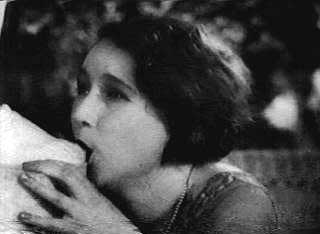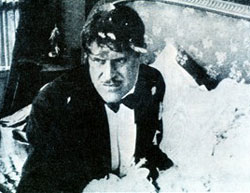 L'Âge d'Or (The Golden Age, 1930)
L'Âge d'Or (The Golden Age, 1930)Director: Luis Buñuel
If you asked me who I thought was the best director of all time, I’d answer Stanley Kubrick. I love every one of his films because they are epic in both the size of their stories and the scope of their ideas, visually stunning, and exquisitely edited. His films were made with the studied slowness of a master craftsman, compensation for his small output. Stanley Kubrick appeals to my sense of grandeur, beauty, and wonder.
Now if you asked me to name my favorite director, I would answer without hesitation Luis Buñuel. He is almost the polar opposite of Kubrick. His interest is in the disorderly darkness of small minds, and he is virtually indifferent to production values. From film to film, his ideas are repetitive and personal. He made films quickly, including a lot of hack work. He is anything but studied. But he has what Kubrick lacks—an irrepressible and irresistible glee!
Those familiar with Buñuel know his films linger on sexual obsession and perversion, an almost superstitious rejection of the Catholic Church, and the hypocrisy of the upper classes. You will find women strapped into fuck-me shoes in many of his films. He also enjoys mannequins and prosthetic legs, which his ridiculous male protagonists tend to fetishize. His clergymen seem to do more harm than good; for example, Nazarin (1959) shows a despised priest set off into the countryside to spread Christ’s good word. Why despise such a humble man? Because he causes trouble wherever he goes, from labor strikes to premature death! Buñuel also likes to fill his scenes of bourgeois life with farm animals or have his well-heeled characters walk endlessly to nowhere.
You’d think that seeing him lampoon his favorite targets in familiar ways would get old after a while, but I never tire of his vision. His films are filled with joy, his targets richly deserving of the pantsing they get, and his ideas truly unique. It was with great anticipation, therefore, that I viewed L'Âge d'Or.
L'Âge d'Or is Buñuel's second film with Salvador Dali. The two surrealists made a sensation when their maiden film together Un Chien Andalou (1929), a compilation of dream images, shocked Paris audiences with the slicing of a woman's eyeball in the opening sequence. The French surrealists gave it a standing ovation and hailed it as the first true surrealist film. L'Âge d'Or could be considered something of a sequel by the pair, at least in its refusal to make much sense and in the overall dreamlike quality it creates. But Buñuel directed this film alone, placing more emphasis on narrative than Dali was likely to impart.
The film starts with a nature treatise on the scorpion. We are instructed in the structure of a scorpion's tail, the nature of the venom it injects when stinging its victims, and how handy it is in overpowering rats. We see scorpions fight amongst themselves, and sting a rat on the nose, causing it to scratch furiously at itself. Are we being fed an allegory for the rest of the film? Not really. Luis just likes showing insects on screen.
Next we see a half-dead Spanish partisan (Max Ernst, the founder of the surrealist movement) trudging from a craggy shore. He sees four bishops praying on some coastal rocks. He returns to a hovel where his comrades are wasting away. He informs them that the Majorcans have landed. They go off to fight, but one by one they fall in their tracks. Boats land and a strange assortment of gentry climb onto shore, where the rotted bones of the bishops are strewn among their clerical garb. Next, we learn that the great city of Rome was founded, and get postcard views, deliberately called out like a tour guide.
 Other odd ceremonies ensue, but the pivotal moment is when a man (Gaston Modot, a painter and friend of Picasso, later a full-time actor) is pulled off a screaming woman as he attempts to rape her in the mud. Handcuffed, he is marched into--and all over--town. The man is enraged by things of nature--kicking a barking dog and squashing a beetle. He ends up at a fancy ball where he encounters the lover (Lya Lys) about whom he has been fantasizing. A donkey cart wheels across the ballroom floor unnoticed by the partygoers. The man slaps his lover's mother for spilling sherry on him. The partygoers are outraged, but the woman is thrilled. The lovers meet for a tryst in the formal gardens, but the man is grabbed away from the woman. Still in the throes of sexual ecstacy, she sucks the toes of a statue.
Other odd ceremonies ensue, but the pivotal moment is when a man (Gaston Modot, a painter and friend of Picasso, later a full-time actor) is pulled off a screaming woman as he attempts to rape her in the mud. Handcuffed, he is marched into--and all over--town. The man is enraged by things of nature--kicking a barking dog and squashing a beetle. He ends up at a fancy ball where he encounters the lover (Lya Lys) about whom he has been fantasizing. A donkey cart wheels across the ballroom floor unnoticed by the partygoers. The man slaps his lover's mother for spilling sherry on him. The partygoers are outraged, but the woman is thrilled. The lovers meet for a tryst in the formal gardens, but the man is grabbed away from the woman. Still in the throes of sexual ecstacy, she sucks the toes of a statue.It turns out that the man is a goodwill ambassador in whom much trust has been placed. Those who would have taken him away are forced to release him, baffled. The film ends with a story of sexual debachery and murder in a fortress, showing us several members of the gentry following a man who looks like Jesus out of the castle gate.
Watching this film was like looking at a sketchbook, with all of Buñuel's iconography coming into being--the sexually obsessed man, the insects, the clergy, the livestock.
 At one point, the woman walks into her bedroom and angrily shoos a cow off her bed, as though it were a house pet. This linking of livestock with gentility reminds us that we are animals, too, particularly in bed. In Buñuel's films, the women generally are very refined (in Viridiana, the main character is a novice at a convent) but are shown to be as sexually obsessed and twisted as the men who pursue them. But they all seem to be such happy perverts that I can never condemn them, no matter how outrageously they behave (for example, in El, the insanely jealous bourgeois husband attempts to sew his wife's vagina closed).
At one point, the woman walks into her bedroom and angrily shoos a cow off her bed, as though it were a house pet. This linking of livestock with gentility reminds us that we are animals, too, particularly in bed. In Buñuel's films, the women generally are very refined (in Viridiana, the main character is a novice at a convent) but are shown to be as sexually obsessed and twisted as the men who pursue them. But they all seem to be such happy perverts that I can never condemn them, no matter how outrageously they behave (for example, in El, the insanely jealous bourgeois husband attempts to sew his wife's vagina closed).A few scenes have a painterly touch that only Dali could have created, for example, one in which we see the back of the woman's head like a madonna in an ethereal heaven as she gazes into her mirror that dissolves into a cloud tableau. Despite the artistic success of the film, L'Âge d'Or ended the Dali-Buñuel collaboration. Buñuel went on to make Las Hurdes (Land without Bread), a socialist documentary and other more politically charged films before settling into his fictional critiques of society with such scandalous and brilliant films as The Exterminating Angel, Belle de Jour, and his last and best film, That Obscure Object of Desire. Peculiar as some of his ideas may seem, here was a man who knew what he wanted, pleasing himself behind the camera and, in the process, pleasing so many moviegoers, too. l
Dear readers, this is a repost that includes the pictures I so wanted to show you. Blogger was not my friend for a while on this one, but persistence--and an enomous love of Luis--paid off in the end.


0 Comments:
Post a Comment
<< Home